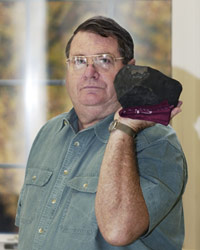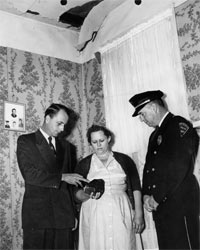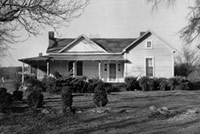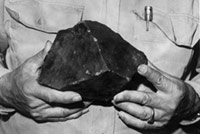
TUSCALOOSA, Ala. – One of the world’s most famous rocks – a meteorite that struck an Alabama woman 50 years ago this month – is the subject of a Nov. 30 presentation sponsored by The University of Alabama’s Alabama Museum of Natural History, home to the legendary stone.
The “Hodges Meteorite” fell from the sky on Nov. 30, 1954, punching a hole in the roof of a house in the Oak Grove community, near Sylacauga, smashing a wooden radio cabinet and then landing on 31-year-old Ann Hodges, as she lay dozing on her couch. The meteorite, which weighed about 8.5 pounds, hit Hodges’ hand and hip and caused extensive bruising, according to published reports from the period.
The only confirmed occurrence of a meteorite hitting a human, the incident resulted in an Air Force investigation, a mini bidding war, a flurry of media attention and a lawsuit. Hodges, against her husband’s wishes, donated the internationally publicized meteorite to the University’s Alabama Museum of Natural History in 1956, said Dr. John C. Hall, retired assistant director of the UA museum.
Hall will give a talk, “Ann Hodges and the Day the Star Fell” at 7 p.m., Nov. 30 in room 205 of Smith Hall. The public is invited, and admission is free. A reception will be held in the Grand Gallery following the talk.

Hall, former director of the Alabama Museums Association, said meteorites in space may travel at a rate of more than 30,000 miles per hour. Smaller ones break up and are slowed down, and burned, as they enter the earth’s atmosphere.
“Still, the Hodges meteorite was clearly traveling several hundred miles per hour when it struck the house,” Hall said. The object is known as a chondrite, a common form of stony meteorite. Scientists have dated meteorites similar to this one as having been formed during the early years of the solar system, approximately 4 to 5 billion years ago, Hall said.
Media reports at the time indicated people from Georgia to Mississippi reported seeing a bright light in the sky and some heard an “explosion” near the time Hodges was struck.
A representative of the Geological Survey of Alabama, who was in Sylacauga at the time of the incident, first confirmed the meteorite’s authenticity. Hall said the loud noise people reported hearing was likely a sonic boom produced by meteorites traveling many times the speed of sound. A second, smaller fragment was discovered the next day about two miles from the Hodges’ home, he said. It is on display in the Smithsonian, whose representative unsuccessfully attempted to obtain the more famous meteorite from the Hodges.

A helicopter crew from Maxwell Air Force Base flew to Sylacauga later that afternoon, Hall said, and went to the Hodges’ home – which, ironically, was located near the Comet Drive-In – to examine the meteorite. With the threat of atomic bombs and fears associated with Communism serving as a backdrop in the early 1950s, the Air Force was under orders to confiscate any items from space, the retired UA naturalist said. So, the Air Force took the meteorite to Wright-Patterson Air Force Base in Ohio. Quickly confirming the meteorite was not part of a spacecraft, the Air Force lost interest in the rock, Hall said, and it was later returned to the Hodges.
However, the Hodges’ landlord sued for possession of the grapefruit-sized rock, but the sides reached an out of court settlement, and the Hodges retained possession.

The 7 inch by 5 inch by 5 inch rock, displayed at the Museum underneath a glass case, is covered with a thin black coating from its heated entry, Hall said. It contains several chips, and a patch of tar from the Hodges’ roof remains visible on one tip, he said.
The stone was likely a fragment from a meteorite that probably weighed more than 150 pounds when it entered the atmosphere. Meteorites smaller than 150 pounds generally do not survive passage through the earth’s atmosphere, he said.
Hall called the meteorite the Museum’s “most memorable” exhibit. “This is the main thing that people from outside the state come to the Museum to see,” he said.
UA’s Alabama Museum of Natural History is located in Smith Hall on 6th Avenue near the Quad on The University of Alabama campus. The typical hours of operation are Tuesday through Saturday, from 10 a.m. to 4:30 pm. Standard admission is $2 for adults and $1 for children and seniors. To see a complete list of upcoming activities and events visit the website at www.museums.ua.edu.
Contact
Chris Bryant, Assistant Director of Media Relations, 205/348-8323, cbryant@ur.ua.edu
Source
Dr. John Hall, 205/348-7554, jhall@bama.ua.edu